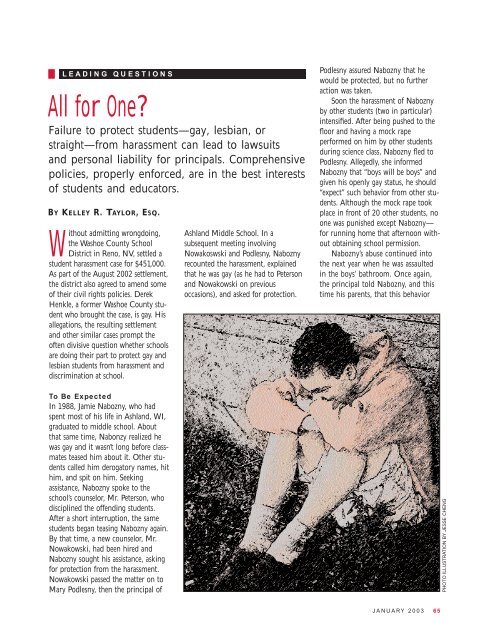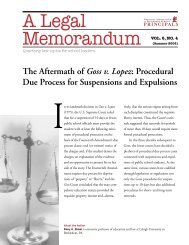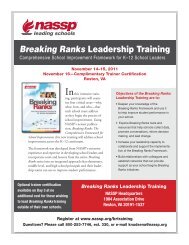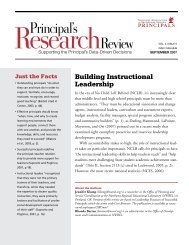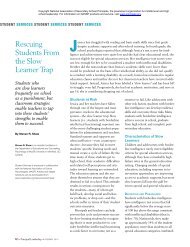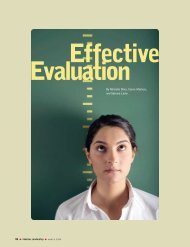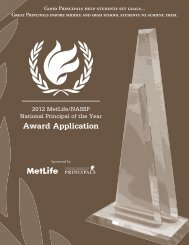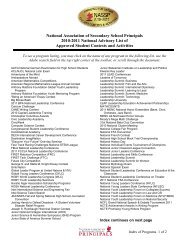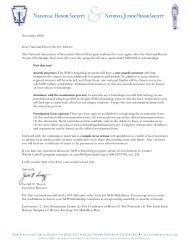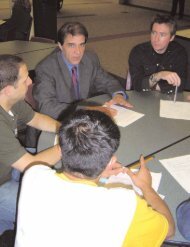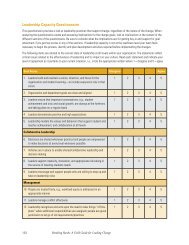All for One? - National Association of Secondary School Principals
All for One? - National Association of Secondary School Principals
All for One? - National Association of Secondary School Principals
Create successful ePaper yourself
Turn your PDF publications into a flip-book with our unique Google optimized e-Paper software.
LEADING QUESTIONS<strong>All</strong> <strong>for</strong> <strong>One</strong>?Failure to protect students—gay, lesbian, orstraight—from harassment can lead to lawsuitsand personal liability <strong>for</strong> principals. Comprehensivepolicies, properly en<strong>for</strong>ced, are in the best interests<strong>of</strong> students and educators.BY KELLEY R. TAYLOR, ESQ.Without admitting wrongdoing,the Washoe County <strong>School</strong>District in Reno, NV, settled astudent harassment case <strong>for</strong> $451,000.As part <strong>of</strong> the August 2002 settlement,the district also agreed to amend some<strong>of</strong> their civil rights policies. DerekHenkle, a <strong>for</strong>mer Washoe County studentwho brought the case, is gay. Hisallegations, the resulting settlementand other similar cases prompt the<strong>of</strong>ten divisive question whether schoolsare doing their part to protect gay andlesbian students from harassment anddiscrimination at school.To Be ExpectedIn 1988, Jamie Nabozny, who hadspent most <strong>of</strong> his life in Ashland, WI,graduated to middle school. Aboutthat same time, Nabonzy realized hewas gay and it wasn’t long be<strong>for</strong>e classmatesteased him about it. Other studentscalled him derogatory names, hithim, and spit on him. Seekingassistance, Nabozny spoke to theschool’s counselor, Mr. Peterson, whodisciplined the <strong>of</strong>fending students.After a short interruption, the samestudents began teasing Nabozny again.By that time, a new counselor, Mr.Nowakowski, had been hired andNabozny sought his assistance, asking<strong>for</strong> protection from the harassment.Nowakowski passed the matter on toMary Podlesny, then the principal <strong>of</strong>Ashland Middle <strong>School</strong>. In asubsequent meeting involvingNowakoswski and Podlesny, Naboznyrecounted the harassment, explainedthat he was gay (as he had to Petersonand Nowakowski on previousoccasions), and asked <strong>for</strong> protection.Podlesny assured Nabozny that hewould be protected, but no furtheraction was taken.Soon the harassment <strong>of</strong> Naboznyby other students (two in particular)intensified. After being pushed to thefloor and having a mock rapeper<strong>for</strong>med on him by other studentsduring science class, Nabozny fled toPodlesny. <strong>All</strong>egedly, she in<strong>for</strong>medNabozny that “boys will be boys” andgiven his openly gay status, he should“expect” such behavior from other students.Although the mock rape tookplace in front <strong>of</strong> 20 other students, noone was punished except Nabozny—<strong>for</strong> running home that afternoon withoutobtaining school permission.Nabozny’s abuse continued intothe next year when he was assaultedin the boys’ bathroom. Once again,the principal told Nabozny, and thistime his parents, that this behaviorPHOTO ILLUSTRATION BY JESSE CHENGJANUARY 2003 65
LEADING QUESTIONSshould be expected. The harassmentcontinued, as did meetings withNabozny, Nabozny’s parents, andPodlesny. In every instance, Podlesnytook no action. Nabozny attemptedsuicide and attempted to changeschools be<strong>for</strong>e having to re-enroll inAshland High <strong>School</strong> where he wasurinated on in the boys’ bathroom andbeaten severely in the school hallway.During that time, the AshlandHigh <strong>School</strong> principal, assistant principal,guidance counselor, police liaison,and school <strong>of</strong>ficial in charge <strong>of</strong>discipline all in some way or anotherdisregarded the abuse. In fact, the <strong>of</strong>ficialin charge <strong>of</strong> school discipline,Blauert, reportedly laughed whenNabozny suffered an in-school beatingthat lead to internal bleeding, sayingthat Nabozny deserved the treatmentas a result <strong>of</strong> being gay.By the time Nabozny withdrewfrom Ashland High <strong>School</strong>, he was an11th-grade student who had beenbeaten, hit with nuts and bolts, spit on,verbally harassed, placed in special educationclasses with his harassers, andlaughed at and ignored by school <strong>of</strong>ficials.He twice attempted suicide andwas diagnosed with post-traumaticstress disorder.In 1995, Nabozny filed suit againstPodlesny, Davis, Blauert, and theschool district, alleging violation <strong>of</strong> hisconstitutional rights to equal protectionand due process. The district courtruled in favor <strong>of</strong> the defendants(dismissing the case without a trial),but the U.S. Court <strong>of</strong> Appeals <strong>for</strong> theSeventh Circuit (covering Illinois, Indiana,and Wisconsin) overturned thatdecision in 1996. In doing so, theCourt <strong>of</strong> Appeals ruled that publicschools and school <strong>of</strong>ficials could beheld individually liable <strong>for</strong> failing toaddress student-to-student anti-gayharassment and discrimination.Additionally, the court made animportant statement that “the EqualProtection Clause does...require thestate to treat each person with equalregard, as having equal worth, regardless<strong>of</strong> his or her status.” The SeventhCircuit ruling led to Nabozny winninga $900,000 out-<strong>of</strong>-court settlementagainst the three school administratorsnamed in the appeal.Nabozny was a seminal case <strong>for</strong>holding school administrators liable<strong>for</strong> failing to deal effectively andappropriately with student-to-studentanti-gay harassment. In the years sincethat ruling, many similar cases in variousstates have been filed by gaystudents who have allegedly sufferedharassment at the hands <strong>of</strong> fellow studentswithout appropriate schoolattention or intervention. The 2002case involving Derek Henklementioned in the introduction to thisarticle is only one <strong>of</strong> many. The seemingregularity <strong>of</strong> such harassment inschools makes it important that schoolleaders fully understand their duty tosafeguard the civil rights <strong>of</strong> allstudents.Matters <strong>of</strong> OpinionOften, individual opinions eclipse fundamentallegal principles that delineateschool <strong>of</strong>ficials’ responsibilities. Giventhe highly sensitive and usually inharmoniousviewpoints surroundinghomosexuality proper procedure issometimes skewed in school-relatedmatters involving gay and lesbian students.A situation involving the EqualAccess Act, a federal law that requiresschool <strong>of</strong>ficials to treat student clubsand organizations equally with regardto access to school resources, serves asillustration.In August 1999, a student at ElModena High <strong>School</strong> in OrangeCounty, CA, decided to <strong>for</strong>m a Gay-Straight <strong>All</strong>iance (GSA) club at theschool. In accordance with school policy,the student submitted to school<strong>of</strong>ficials a proposed club constitutionalong with other required paperwork.That stated purpose <strong>of</strong> the group wasto “promote interest in a supportivecommunity amongst peers.” Duringclub meetings, members planned toengage in discussion and attendlectures, field trips, and other activitiesto raise public awareness and promotetolerance. Membership would be opento all students whether gay or straight.The school’s policy allowedstudent-initiated groups to meet onschool grounds during lunch and touse school facilities to publicize meetingsand activities. At the time, theschool had 38 non-curriculum-relatedstudent groups, including an AsianClub, the Black Student Union, aChristian Club, and a Girls League.As a result, the student felt confidentthat his application would beapproved.Un<strong>for</strong>tunately, the school’s principal<strong>for</strong>warded the student’s applicationto the assistant superintendent.This was not normal procedure <strong>for</strong>approval <strong>of</strong> such an application.What ensued were months <strong>of</strong> wranglingbetween the student andschool <strong>of</strong>ficials, with school <strong>of</strong>ficialsasking the student to change thename <strong>of</strong> the club, holding public<strong>for</strong>ums on whether the club shouldbe approved, and finally denying theclub’s application. The student,Anthony Colin, and the GSA laterfiled suit against the Orange CountyUnified <strong>School</strong> District, the schoolboard, and the principal alleging violation<strong>of</strong> their rights under federallaw and the U.S. Constitution. Followingan evidentiary hearing, ajudge granted the plaintiff’s request<strong>for</strong> an injunction. In doing so, heordered the school to allow theGSA to meet on school groundswith the same equal access to schoolfacilities that the school grantedother student clubs.Colin is a good example <strong>of</strong> howa school administrator’s decisionsconcerning students can be affectedby compelling yet subjective individualmoral opinions and views. Moreimportantly, Colin, Nabozny, andHenkle serve to highlight an important66 P RINCIPAL L EADERSHIP
LEADING QUESTIONSthat <strong>for</strong>mulating and implementingsound policies is crucial. When policiesare established, adhered to, andapplied in an even-handed manner, itis difficult <strong>for</strong> a court to find a schooladministrator personally liable. Withthis in mind, <strong>for</strong>mulating a comprehensive,easily understood and properlyen<strong>for</strong>ced policy—whethergoverning harassment, equal access, orother school-related issues— is aessential step toward limiting liability<strong>for</strong> denial <strong>of</strong> equal treatment andimproving the level <strong>of</strong> safety in theschool environment.In laying the foundation <strong>for</strong> yourschool’s policy, it is advisable to firstdevelop a convincing and effectivephilosophy about the issues that arethe subject <strong>of</strong> the policy. For example,in the case <strong>of</strong> discrimination andharassment, a “no tolerance”approach, applicable to all persons inthe school, may be advisable. Withrespect to equal access, the policyshould clearly state the school’s positionrelated to student clubs andorganizations. At all times, whendeveloping policy, your legal duty toprotect students and to make school asafe and learning conductive environmentshould be your guide.Although important, policy developmentis only one part <strong>of</strong> the process<strong>of</strong> curbing harassment and discriminationand ensuring equal treatment inschool. Indeed, having policies that arenot properly en<strong>for</strong>ced is akin to nothaving policies at all. In suits broughtagainst school <strong>of</strong>ficials <strong>for</strong> failure toprotect students from harassment ordiscrimination, a key question will bewhether the action taken in response tothe complaint was actually effective. Asa result, investigation, documentation,and follow-up should be undertaken inall instances. Establish an adaptableinvestigative process and thorough documentationand follow-up procedures.<strong>All</strong> school policies should alsoset <strong>for</strong>th fair and comprehensivegrievance procedures. Although“When policies are established, adhered to, and appliedin an even-handed manner, it is difficult <strong>for</strong> a court t<strong>of</strong>ind a school administrator personally liable.specific investigative procedures mayvary, all investigations should betimely, detailed, and impartial. <strong>All</strong>complaints, including rumors, shouldbe heeded. At all times your goalshould be fair and appropriate resolution<strong>of</strong> complaints with a tough butaccommodating approach thatrespects confidentiality and includesappropriate and effective correctiveaction.It is also extremely important todocument every step <strong>of</strong> an investigation.Good records may illuminatepatterns, practices, or otherwise pervasivesituations among particularstudents. Moreover, solid documentationcan be useful in the event <strong>of</strong> alawsuit. Beyond investigation anddocumentation is follow-up—one <strong>of</strong>the most important phases <strong>of</strong> the policyen<strong>for</strong>cement process. Follow-upinvolves notification to parties <strong>of</strong> theoutcome <strong>of</strong> the investigation and mayalso involve appeals or provisions <strong>of</strong>other support services to thoseinvolved.A Common ConcernBullying and harassment <strong>of</strong> students isnot a new phenomenon. We all probablyrecall being teased or bothered byclassmates. Some <strong>of</strong> us chalked it up to“growing pains” while others had morepainful experiences not so easily <strong>for</strong>gotten.The reality is that many studentsdread a day at school where they worryabout being harassed or discriminatedagainst by fellow students in ways thatseverely interfere with their ability tolearn. So what are schools doing aboutit? With specific regard to gay andlesbian students, a number <strong>of</strong> schoolboards, districts, and states haveamended their education codes tospecifically include prohibitions ondiscrimination against and harassment<strong>of</strong> gay and lesbian students and facultymembers. Some schools—such as thosein the Houston Independent <strong>School</strong>District—have gone further, holdingtraining sessions to encourage tolerance.Other schools and districts have taken adifferent approach (e.g., opting to prohibitpositive references to homosexualityor to eliminate all cocurricularstudent clubs and organizations ratherthan allow Gay-Straight <strong>All</strong>iances).In the end, harassment andbullying <strong>of</strong> any student is not easilyprevented and school <strong>of</strong>ficials alonecannot curb the problem. However,compassionate and effective schoolleaders understand that the mistreatmentby peers that some studentsencounter in school transcends peerridicule that was (and still is) <strong>of</strong>tendismissed as “innocent” or “typical.”Those school leaders know thatregardless <strong>of</strong> the reason <strong>for</strong> theharassment, students and parentslook to school administrators totake such complaints seriously andto make every reasonable ef<strong>for</strong>t tomake schools safe places where allstudents are supported and able toobtain an education. PLResources❏ Curtis, K. (August 29, 2002).<strong>School</strong>s pay harassed gay student$451,000 [Electronic version]. ChicagoSun Times.❏ Hewitt, P. (April 3, 2002). Seekingtolerance [Electronic version]. HoustonChronicle.❏ Nabozny v. Podlesny, Davis, Blauert,et al. 92 F.3d 446 (7th Cir. 1996).Kelley R. Taylor, Esq., (Taylor_KR@msn.com) is a corporate attorney andfreelance writer based in Virginia.68 P RINCIPAL L EADERSHIP


